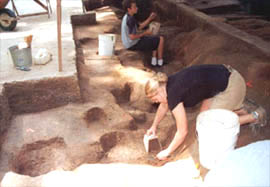 A University of Alabama Museum of Natural History archaeological team recently discovered the remains of a type of 15th-century Native American council house never before found in Alabama.
A University of Alabama Museum of Natural History archaeological team recently discovered the remains of a type of 15th-century Native American council house never before found in Alabama.
Known as an earthlodge, the structure was a place where chiefs of the Moundville Indians met with their council to make important decisions. It was uncovered in late June by a team excavating at Moundville as part of the museum’s Expedition Program, an annual scientific dig with professional and academic instructors guiding lay people in archaeological techniques.
Under the guidance of Dr. Vernon James Knight, curator of Southeastern Archaeology for the UA Museum of Natural History and a UA anthropology professor, the group discovered, on the surface of a large mound, the burned, collapsed remains of the rare structure, believed to be about 550 years old. Ceramic smoking pipes, decorated pottery fragments and other artifacts have also been recovered from the site.
“This is a unique and special find,” Knight said. “The site was generally abandoned about 1500 when the tribal chiefs split up.”
A few earthlodges have been found in the southern Appalachians and in Georgia, but until now archaeologists did not previously believe they existed as far west as Alabama’s prehistoric Moundville. The large, square earthlodge was a semi-underground, wooden building, with narrow entrance tunnels bordered by timber walls. In addition to the smoking pipes and pottery fragments, a stone ax head and bits of native copper have been recovered. These and other remains will inform archaeologists about the activities conducted in the lodge by the prehistoric natives of Moundville.
Contact
Drew Wood or Linda Hill, UA Media Relations, 205/348-8325, lhill@ur.ua.edu
Source
Holly Luther, UA Women's Resource Center, 205/348-5040, hmorris@sa.ua.edu